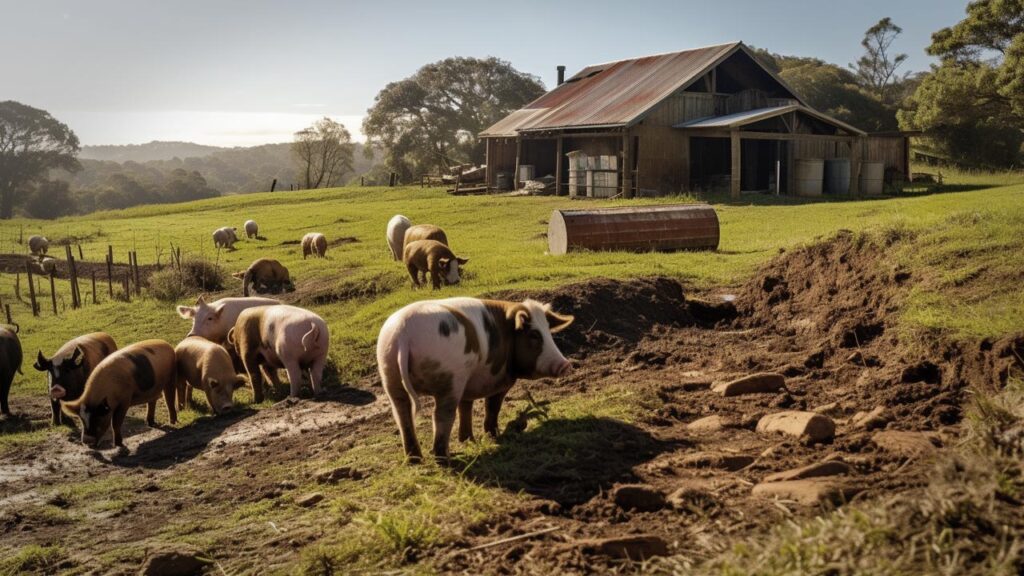The Building Blocks for a Successful Self-Sufficient Homestead
Self-Sufficient Homestead and Self-Reliance are two topics that have become increasingly important in recent times. Today, wearing my Sunday best, I’m going to cover this topic because it is of great importance to me and I think it will be for you too. With the growing importance in sustainable living, more people are looking to become self-sufficient.
Key Takeaways
- Understanding the basics of self-reliance and homesteading.
- Steps to establish and maintain a self-sufficient homestead.
- Building essential skills and overcoming challenges in homesteading.
Table of Contents
- Introduction
- Understanding Self-Reliance and Homesteading
- Key Components of a Self-Sufficient Homestead
- Steps to Establish a Self-Sufficient Homestead
- Building Block Skills
- Real Life Essential Skillset +video
- Challenges and Solutions
- Successful Self-Sufficient Homesteads
- Frequently Asked Questions
- Additional Resources
- Final Thoughts
Introduction
The idea of self-reliance and homesteading is growing. These concepts, rooted in independence and sustainable living, offer an empowering alternative to the conventional lifestyle. This article delves into what self-reliance and homesteading entail and how to embark on this rewarding journey.

Understanding Self-Sufficiency and Homesteading
What is Self-Reliance?
“Self-reliance” is a concept that emphasizes the importance of relying on one’s own capabilities, judgment, and resources, rather than depending on external support or intervention. It’s a principle that encourages individuals to be independent and self-sufficient. Here’s a more detailed explanation:
- Independence in Decision-Making and Actions: Self-reliance means making decisions based on one’s own judgment and preferences. It involves trusting your instincts and abilities to navigate life’s challenges without overly depending on others for guidance or approval.
- Self-Sufficiency in Meeting Basic Needs: This aspect of self-reliance is about providing for oneself, without relying on external systems or assistance. In practical terms, it could mean growing your own food, repairing your own home, or generating your own electricity. It’s about having the skills and knowledge to sustain oneself.
- Emotional and Psychological Resilience: Self-reliance is also an emotional and mental state. It involves having the confidence and self-assurance to handle life’s ups and downs. Self-reliant individuals often display a strong sense of self-esteem and resilience, which helps them to navigate through difficult situations and make sound decisions independently.
- Preparedness for Emergencies: Being self-reliant also means being prepared for unforeseen circumstances, whether it’s a natural disaster, financial crisis, or personal hardship. It involves having contingency plans and resources in place to handle such situations effectively.
- Development of Personal Skills and Knowledge: To be self-reliant, one must continuously acquire and refine skills that enable independence. This could include learning how to grow food, manage finances, or acquire DIY skills for home maintenance.
- Ethical and Moral Autonomy: Self-reliance extends to moral and ethical decision-making. It involves forming one’s own beliefs and values independently and standing by them, even in the face of opposition or societal pressure.
What is Homesteading?
“Homesteading” refers to the practice of establishing a self-sustaining home or farm, where the residents aim to be as self-sufficient as possible. This lifestyle encompasses various activities and principles:
- Self-Sufficiency in Food Production: One of the core elements of homesteading is growing your own food. This can include cultivating fruits, vegetables, and herbs, as well as raising animals for meat, eggs, and dairy products. The goal is to reduce reliance on external food sources, thereby ensuring a steady supply of fresh and healthy produce.
- Energy Independence: Many homesteaders strive to generate their own energy, often through renewable sources like solar, wind, or hydro power. This aspect of homesteading aligns with the goal of minimizing dependence on external energy providers and reducing one’s carbon footprint.
- Sustainable Living Practices: Homesteading is heavily grounded in sustainability. This means using natural resources responsibly, recycling and composting waste, and adopting eco-friendly practices in daily life. It’s about living in harmony with the environment and minimizing ecological impact.
- DIY Mindset: Homesteaders typically embrace a do-it-yourself approach, acquiring skills in areas like carpentry, plumbing, and general repair. This skillset allows them to build, maintain, and improve their homesteads without relying heavily on outside help.
- Community and Self-Reliance: While homesteading emphasizes self-reliance, it also often involves building a sense of community. Many homesteaders share skills, trade goods, and support each other, creating a network of mutually beneficial relationships.
- Historical Roots: The concept of homesteading has historical roots, especially in the United States. It dates back to the Homestead Act of 1862, which allowed people to claim and settle on government land in the western territories. Modern homesteading revives and adapts these principles for contemporary living.
- Adaptability to Various Environments: Homesteading can be adapted to different settings, from rural areas to urban environments. Urban homesteading, for example, might involve smaller-scale practices like balcony gardening, beekeeping, or rainwater harvesting.
Key Components of a Self-Sufficient Homestead, Sustainable Living, Off-Grid Living
Growing Your Food
Embrace ecological gardening to grow your own food. Techniques like companion planting, crop rotation, and eco-friendly pest control are vital. Preserving and storing food also plays a crucial role in self-sufficiency. More resources about Growing your food
Raising Livestock
Consider livestock that suits your space and needs. Options include dairy cows for milk, sheep and goats for dairy products, chickens for eggs and meat, and beekeeping for honey and pollination.
Water Management
Implement strategies beyond rainwater harvesting, such as greywater recycling and water-wise landscaping, to conserve water efficiently.
Energy Production
Adopt off-grid energy solutions like solar power systems, wind turbines, and hydroelectric power. Small changes like using LED lights and Energy Star appliances also contribute to energy conservation. More resources about Energy Production
Waste Management
Effective waste management involves composting and recycling. Learning to compost different types of household waste is essential for a successful homestead.

Steps to Establish a Self-Sufficient Homestead
- Assessing Your Goals and Resources
- Start by evaluating what you want to achieve with your homestead. Consider factors like food self-sufficiency, energy independence, and sustainability.
- Take stock of the resources at your disposal, including land, budget, time, and personal skills. This assessment will guide your planning and implementation stages.
- Finding the Right Location
- The choice of location is crucial. Look for land that meets your needs in terms of climate, soil quality, water availability, and legal regulations related to homesteading activities.
- Consider the proximity to markets, communities, and resources like water bodies or forests, depending on your homesteading goals.
- Planning Your Homestead Layout
- Design your homestead layout with careful consideration. Plan where to locate your home, gardens, animal pastures, and energy sources like solar panels or wind turbines.
- Think about the workflow and efficiency, such as the proximity of the garden to the kitchen or the water source to the fields.
- Building Infrastructure
- Construct essential structures like a house, barns, greenhouses, and storage sheds. Prioritize eco-friendly and sustainable building methods.
- Ensure that your buildings are well-insulated, have efficient water systems, and are designed to maximize natural light and heat.
- Developing a Sustainable Food System
- Start by setting up a vegetable garden. Choose crops suitable for your climate and soil type. Incorporate permaculture principles to enhance sustainability.
- Consider raising livestock for meat, dairy, and eggs. Select animals that are appropriate for your land size and climate, and ensure their welfare with proper care and shelter.
- Establishing Energy Independence
- Explore renewable energy options like solar panels, wind turbines, or micro-hydro systems. Determine what works best for your location and energy needs.
- Implement energy-saving measures like efficient appliances, LED lighting, and water-saving devices.
- Water Management and Conservation
- Set up systems for rainwater harvesting and greywater recycling to maximize water use efficiency.
- Implement irrigation strategies that conserve water, such as drip irrigation or xeriscaping.
- Waste Management
- Establish composting systems for organic waste. This not only reduces landfill waste but also provides valuable nutrients for your garden.
- Recycle and repurpose materials wherever possible to minimize waste and reduce costs.
- Learning and Skill-Building
- Continuously acquire new skills and knowledge essential for homesteading, such as gardening, carpentry, animal care, and food preservation.
- Attend workshops, join homesteading communities, and read extensively to stay informed and adapt to new methods and technologies.
- Community Engagement and Networking
- Engage with local homesteading communities for support, knowledge exchange, and resource sharing.
- Consider forming or joining cooperatives for shared access to tools, seeds, and other resources.

Building Blocks Skills for a Self-Sufficient Homestead
- Agricultural and Gardening Skills
- Learn the basics of soil health, crop rotation, and organic pest control to manage a productive garden.
- Understand the principles of permaculture, which include sustainable land use design and creating symbiotic relationships between elements of the homestead.
- Develop skills in planting, nurturing, and harvesting a variety of crops suited to your climate and soil.
- Animal Husbandry
- Gain knowledge in raising different types of livestock such as chickens, goats, cows, and bees, understanding their specific care requirements, feeding, and health management.
- Learn about breeding practices, birthing, and raising young animals, as well as humane handling and, if applicable, processing.
- Food Preservation and Cooking
- Master techniques like canning, drying, fermenting, and freezing to preserve surplus produce.
- Develop cooking skills that make the most of your homegrown produce and livestock, including baking, dairy processing, and meat preparation.
- More resources about Food Preservation
- Carpentry and Construction
- Acquire basic carpentry skills for building and maintaining structures on your homestead, such as coops, greenhouses, and storage facilities.
- Understand essential maintenance and repair techniques to keep structures safe and functional.
- Energy Management
- Gain knowledge in setting up and maintaining renewable energy systems like solar panels or wind turbines.
- Learn about energy efficiency in the home, including insulation techniques and energy-saving practices.
- Water Management
- Understand the principles of rainwater harvesting and greywater systems to optimize water usage.
- Develop skills in irrigation and water conservation to maintain gardens and livestock with minimal waste.
- Basic Veterinary Care
- Learn basic animal health care, including administering vaccinations, treating common ailments, and emergency first aid for livestock.
- Community Building and Networking
- Engage with the homesteading community for mutual support and learning.
- Learn about cooperative buying, sharing resources, and community trading systems.
- Self-Education and Continuous Learning
- Commit to ongoing learning and adaptation, staying informed about new techniques, technologies, and sustainable practices.
- Utilize resources like books, online courses, workshops, and local homesteading groups to expand your knowledge base.
- Natural Resource Management
- Understanding the ecosystems on your homestead is vital. Learn how to manage and conserve natural resources like forests, water bodies, and wildlife.
- Develop skills in identifying and using native plants for food, medicine, and landscaping. This includes foraging, ethical wildcrafting, and incorporating native species into your homestead’s ecosystem.
- Emergency Preparedness and Resilience
- Homesteaders should be prepared for various emergencies, including natural disasters, medical emergencies, and unforeseen disruptions in supply chains.
- Learn first-aid and basic healthcare skills, including how to respond to injuries and illnesses, especially in remote settings where access to medical facilities might be limited.
- Develop strategies for food and water security in times of crisis, including maintaining an emergency supply of essentials and knowing how to purify water.
- Skills in crisis management, such as adapting to changing circumstances, problem-solving under pressure, and having contingency plans for critical homestead operations, are essential for ensuring resilience and sustainability.

Real Life Essential Skillset
Eric from Country Living Experience outlines his 11 essential skills for aspiring preppers and homesteaders, emphasizing the importance of each skill for self-sufficiency and survival. Here’s a summary of Eric’s key points:
- Food Acquisition: This includes gardening, hunting, and foraging. Gardening involves understanding soil science, water management, pest control, disease management, and knowing the best planting times for various plants. Hunting and foraging are also vital for supplementing diets with meat and wild plants.
- Water Acquisition: Knowing how to source and purify water is critical. This involves setting up rainwater collection systems, using wells, and understanding water purification methods like filters.
- Fire Building: Essential for cooking and heating. It requires skills in acquiring and processing firewood and understanding different methods of starting fires.
- Tool Usage: This covers a wide range of tools necessary for various tasks in homesteading, from gardening tools to mechanical repair tools.
- Construction Skills: These include carpentry, roofing, fencing, and basic plumbing. These skills are important for building and maintaining structures on the homestead.
- Engine Mechanics: Understanding how to maintain and repair small and large machinery is crucial for homesteading.
- First Aid: Basic first aid knowledge is essential for dealing with injuries and health emergencies, especially in remote areas.
- Knot Tying: A practical skill for various purposes around the homestead, from securing loads to tying lines in the garden.
- Knife Skills: A versatile tool, the knife is essential for multiple tasks ranging from gardening to self-defense.
- Animal Husbandry and Veterinary Skills: These skills are important for raising and caring for livestock, understanding their health issues, and managing reproduction.
- Food Preservation: Knowing how to can, freeze, cure, dry, and dehydrate food to make it last through seasons when fresh produce is not available.
Eric’s video also touches on the importance of personal security and self-defense, especially in rural or unstable environments. It emphasizes that while expertise in all these areas is not immediately necessary, working towards gaining these skills is crucial for successful homesteading and preparedness.
Challenges and Solutions in Homesteading
- Balancing Time and Resources
- Challenge: Managing a homestead requires a significant investment of time and resources, which can be overwhelming, especially for beginners.
- Solution: Prioritize tasks based on urgency and importance. Consider automating certain processes, like irrigation systems, to save time. Start small and scale up gradually as you become more comfortable and efficient.
- Dealing with Pests and Diseases
- Challenge: Pests and diseases can pose a serious threat to crops and livestock.
- Solution: Implement integrated pest management (IPM) techniques, which include crop rotation, natural predators, and barriers. For livestock, maintain good hygiene, provide proper nutrition, and ensure regular health checks to prevent diseases.
- Weather and Environmental Factors
- Challenge: Extreme weather conditions like droughts, floods, and storms can significantly impact homesteading activities.
- Solution: Build resilient systems, such as using drought-resistant crop varieties and constructing robust shelters for animals. Practice water conservation and have emergency plans in place for severe weather events.
- Knowledge and Skill Gaps
- Challenge: Homesteading requires a wide range of skills that many beginners may not possess initially.
- Solution: Continuously educate yourself through books, online resources, workshops, and community networks. Don’t hesitate to seek advice from experienced homesteaders.
- Legal and Regulatory Compliance
- Challenge: Navigating zoning laws, building codes, and agricultural regulations can be complex and confusing.
- Solution: Research local laws and regulations thoroughly. Consult with local authorities or a legal advisor to ensure compliance.
- Isolation and Community Integration
- Challenge: Homesteaders, especially in remote areas, can experience isolation.
- Solution: Build a network with nearby homesteaders and participate in local community events. Online forums and social media groups can also provide support and a sense of community.
- Sustainability and Environmental Impact
- Challenge: Ensuring that homesteading practices are sustainable and environmentally friendly can be challenging.
- Solution: Adopt sustainable practices such as composting, rainwater harvesting, and using renewable energy sources. Regularly assess and adjust practices to minimize environmental impact.
Successful Self-Sufficient Homesteads
To inspire and provide practical insights, let’s look at some successful homesteads:
- Polyface Farm in Virginia, USA, showcases sustainable farming with practices like rotational grazing and direct sales to the local community.
- The Nearings’ Homestead in Maine, USA, exemplifies a self-sufficient lifestyle with handmade stone homes and sustainable energy sources.
- Urban Homestead in Pasadena, California, USA, demonstrates how a small urban plot can yield significant food production, including fruits, vegetables, and herbs.
These examples illustrate that a Self-Sufficient Homestead can be adapted to various settings, from rural expanses to urban backyards.
Frequently Asked Questions
Additional Resources
Final Thoughts
My most vital takeaway from this article is the empowering concept of self-reliance. Homesteading is not just about the physical tasks of growing food, raising livestock, or generating energy; it’s about embracing a lifestyle that fosters independence, resilience, and a deep connection with nature.
Self-reliance, as demonstrated through homesteading, encourages us to develop skills that go beyond mere survival; they lead to a more sustainable, fulfilling, and environmentally conscious way of life. The journey of homesteading teaches the value of hard work, the importance of community, and the satisfaction of creating a living space that aligns with one’s values and needs.
Whether in a rural or urban setting, homesteading represents a shift towards a more intentional and self-determined way of life. It challenges the status quo of consumerism and dependence on external systems, offering a path to a more grounded and self-sustained existence.
Ultimately, the journey of building a self-sufficient homestead is as much about personal growth and learning as it is about the tangible outcomes of food production and energy independence. It’s a journey that cultivates not only a flourishing homestead but also a resilient and resourceful homesteader.






Leave A Comment